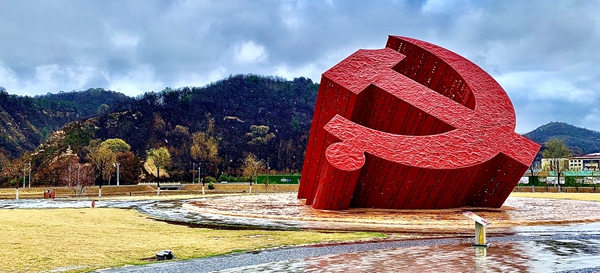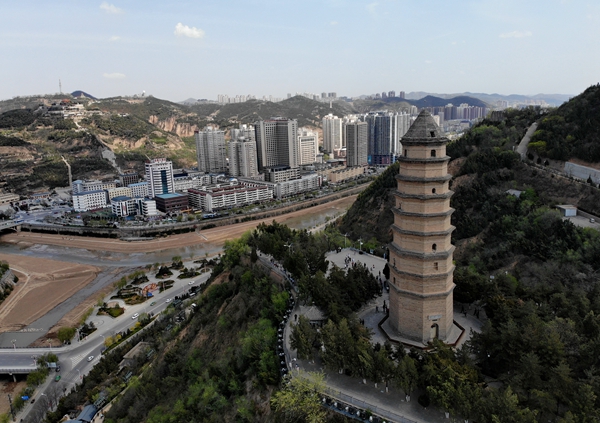
The Nanniwan Revolutionary Site hosts a square containing what it claims is the world's largest hammer-and-sickle statue.[Photo by Erik Nilsson/China Daily]
Yan'an's chapter in China's revolutionary saga makes the city a living museum that shows how its past gives new life to the country's present and future, Erik Nilsson reports.
Yan'an is celebrated as a "red" hot spot in the "land of yellow earth". The city on the Loess Plateau was the revolutionary base of the Communist Party of China after the Red Army arrived in northern Shaanxi following the arduous Long March in the 1930s.
As such, it's home to hundreds of officially recognized revolutionary sites.
This legacy lures people from around the country and world, who visit to understand how its past shapes today and tomorrow. Nearly 80 million visited in 2019 alone. And the city is currently experiencing a massive tourist influx, as China prepares to celebrate the 100th anniversary of the CPC's founding.
It's also a place where, interestingly, not only tourism players but also a large proportion of visitors walk around wearing cos-play replicas of Red Army uniforms.
Yan'an remains a hive of red zeal and a honeycomb of countless cave houses whittled into the hillsides. Ultimately, its revolutionary history has carved its every inch in every sense.
Baota Mountain
Baota Mountain is the city's foremost icon that's synonymous with Yan'an.
The pillars of its emblematic 44-meter-high octagonal Tang Dynasty (618-907) pagoda, from which it derives its namesake, are carved with calligraphic inscriptions that read," rising above Earth", and, "overlooking the world".
Its peak does, indeed, offer a panoramic view of the city, revealing its unique long and narrow layout. Downtown packs the cracks between two rows of steep mountains that've endowed it with defensive advantages since ancient times.
The 360,000-square-meter site also hosts ancient cliff carvings, a beacon tower, the Star Pavilion, the Reform School for Japanese POWs, the Jialing Academy, a Ming Dynasty (1368-1644) flood-warning bell and a commemorative stone-stele forest.
Visitors can stay overnight in a mountainside cave hotel.
Most of the over 300 captured Japanese soldiers held at the reform school between 1941 and '45 later joined the fight against compatriot invaders. The school hosts 30 "cave dorms", an auditorium, a kitchen and sports facilities.
Baota stages a nighttime light show that can be seen and heard throughout downtown with music and dance performances featuring local waist drums.
Indeed, it's so essential to the city's identity that a saying goes: "Only after you've climbed Baota Mountain can you say you've truly been to Yan'an."

The Tang Dynasty pagoda is the city's foremost icon that's synonymous with Yan'an.[Photo by Erik Nilsson/China Daily]
Nanniwan Revolutionary Site
Nanniwan is where the CPC industrialized the wilderness, against all odds.
It hosted the Mass-Production Campaign that transformed vast swathes of thorny no-man's land into productive terrain from 1941 to'44, as a solution to the Kuomintang blockade of the Shaanxi-Gansu-Ningxia border.
The Eighth Route Army's 359th brigade converted wasteland into productive land, creating rice paddies, cave houses and workshops, with only the most rudimentary hand tools at best and often nothing but their bare hands.
The Nanniwan Revolutionary Site hosts a square containing what it claims is the world's largest hammer-and-sickle statue. The sides of the 13.8-meter-high, 19-meter-wide, 21-meter-long copper-and-steel structure are emblazoned with Marx's writings in German and photo exhibitions charting the development of the CPC and the country.
The square is across the street from a 200-square-meter temporary exhibition hall scheduled to be replaced by a 7,000-square-meter museum this year.
It displays farm tools, photos and relics that reveal how Nanniwan's transformation in turn transformed the nation.
1938
1938 takes its namesake from the significant events that took place in Yan'an that year, such as the sixth plenary.
The main attraction is the live show, Yan'an, Yan'an, which is an updated version of a red folk-culture performance presented on rustic stages throughout the region during the revolutionary period.
It's celebrated for its stage technology and special effects, including lasers.
The performance follows the story of Bai Yanming, a college student from Shanghai who traveled to Yan'an in the 1930s, and two Red Army soldiers, as they encounter the vicissitudes of the Long March, Mass-Production Campaign, Japanese bombings and the Red Army's crossing of the Yellow River amid Kuomintang fire.
Over 1 million visitors have watched Yan'an, Yan'an since it debuted in 2016, and the show was recently updated for the 100th anniversary of the CPC's founding.
Actors dance, perform acrobatics and sometimes appear to climb up the walls or fly over audiences' heads.
The crowds, who often attend wearing Eighth Route Army uniforms, bounce inflatable plastic pumpkins, nibble on dates handed out by actresses who play farmers and are showered with red-star shaped confetti.
The building adjacent to the venue is packed with booths selling local handicrafts and folk arts like Shanbei (Northern Shaanxi) paper-cuts and waist drums, and classes on how to create or perform them.

Cave dwellings on Baota Mountain.[Photo by Erik Nilsson/China Daily]
Yan'an Qiaoergou Revolutionary Site
The Yan'an Qiaoergou Revolutionary Site hosted the sixth CPC Central Committee's sixth plenary in 1938.
The session summarized the 17 years since the Party's founding and charted the future of the fight against Japanese invaders and the civil war (1946-49).
Mao Zedong told the CPC's seventh National Congress in 1945: "There were two important and crucial meetings in the history of the Communist Party of China. One was the Zunyi conference in January 1935. The other was the sixth plenary session of the Central Committee in 1938 … (which) was the one that decided the fate of China."
The site contains 52 cave dwellings, 16 tiled houses, a Gothic-style Catholic church and the Luxun Academy of Arts Square.
Yan'an Press Memorial Hall
Downtown Yan'an's Qingliang Mountain accommodated many press and publishing groups in the 1930s and '40s, including the Party Newspaper Committee, Xinhua News Agency, Liberation Daily, Yan'an Xinhua Radio Station, the Central Printing House and Xinhua Bookstore.
The 3,000-square-meter attraction includes 1,580 square meters of exhibitions that display over 180 artifacts and more than 400 historical photographs, documents and diagrams. The museum's cave-house architecture nods to how the Party's journalism developed in these grottoes in Yan'an.
Yan'an Revolutionary Memorial Hall
The Yan'an Revolutionary Memorial Hall was established as one of the earliest of its kind in 1950.
Its massive collection includes more than 35,000 relics, 10,000 photos, 13,000 books and 100 volumes of published research.
The steps leading to the site are divided into three sections that symbolize the agrarian revolution, the War of Resistance Against Japanese Aggression (1931-45) and the civil war.
Its 38,000-square-meter public square hosts a 16-meter-high bronze statue of Mao, among others, including 18 cave homes that house sculptures of CPC members of different backgrounds, reflecting the diversity of people involved in the revolution.
Long March Victory Memorial Hall
The Long March Victory Memorial Hall of the Central Red Army not only hosts the gallery but also a 4.5-square-kilometer area featuring a Long March battlefield, a monument, five public squares and a Red Army command post.
It exhibits photos, statues and relics like guns, uniforms and grass shoes but especially focuses on oil paintings. Perhaps the most famous oil work portrays farmers treating Mao to buckwheat noodles with goat meat upon his arrival in Yan'an.
The attraction hails the Long March's endpoint as a new starting point for the CPC that began in Yan'an, whose legacy has extended throughout time, the country and the world.

